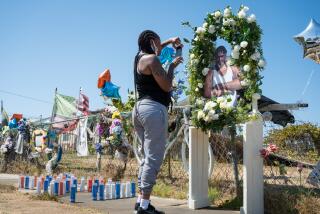Trayvon Martin case: A collision of race, guns and Florida law
- Share via
Sanford, Fla., on Thursday braced for what could be its biggest day of demonstrations over the death of Trayvon Martin, the black teenager shot by a neighborhood watch officer, George Zimmerman, last month. For those just catching up to the case that has galvanized the nation -- raising legal and social issues about race, guns and self-defense -- here’s some background.
What do we know?
The first phase of the case happened the night of Feb. 26.
Martin, 17, was walking back to his father’s house in a gated community in Sanford, a suburb of Orlando, Fla. He had bought a package of Skittles and an iced tea from a convenience store in the city of about 53,000 residents. A majority of the city’s residents are white; just under a third are black.
Zimmerman, 28, was patrolling the neighborhood when he saw Martin. He called police to report his suspicions and then followed the teenager, though police recordings quote the dispatcher as saying he should stay away.
Moments later, Zimmerman -- identified as a Latino by his family, and as white by critics of the subsequent investigation -- was in a confrontation with Martin, ultimately shooting the unarmed teenager once, killing him.
What happened next?
The controversy begins with the second phase -- the aftermath of the shooting.
Local police responded to the incident and questioned Zimmerman; authorities did medical tests on the dead teenager but not on Zimmerman.
According to various reports, police say Zimmerman told them he chased Martin but gave up and was returning to his truck when the teenager attacked him. Police say Zimmerman had blood on the back of his head.
Zimmerman, who is claiming self-defense, was released and has not been charged in the shooting.
What is the family’s position?
The family, backed by national and local civil rights leaders, say that Martin was in danger -- as is any other African American teenager out alone after dark, they add. Because of his race, Martin immediately appeared suspicious to a white person on patrol, especially one whose training was far less than that received by professional police.
Further, the family insists, if a black officer had shot a white teen, he would have been charged and held -- and drug and alcohol tests would have been carried out on the officer and not just the victim, who in this case was drug-free.
“They are making it look like Zimmerman is the victim,” Benjamin Crump, attorney for Martin’s parents said of the police, according to several media interviews. “And their son is in the grave. It’s about equal justice.”
What is the local police position?
Police insist they investigated and let Zimmerman go because officers were “prohibited from making an arrest based on the facts and circumstances they had at the time,” including the physical evidence.
“The Sanford Police Department has conducted a complete and fair investigation of this incident,” police chief Bill Lee said in a prepared statement.
What happens next is up to prosecutors who have convened a grand jury for April 10.
What is the law regarding self-defense?
Florida is one of 21 states with some form of a stand-your-ground law allows people to legally use deadly force if they fear for their life.
In general, the laws, backed by gun rights advocates, allow a person to stay and fight rather than flee a confrontation. The laws have different requirements, depending on the state. Some specify that the shooter has to have a legal weapon and has to have a right to be where he or she is.
It will be up to the grand jury to determine if Zimmerman’s self-defense claim meets Florida’s legal tests, including whether Zimmerman had reason to fear for his life during the confrontation.
The Florida version of the law, backed with the support of the National Rifle Assn., was passed in 2005. According to the Associated Press, Florida Department of Law Enforcement statistics show that, before the law was enacted, there were about 13 so-called justified killings each year by citizens from 2000 to 2005. Between 2006 and 2010, the average has risen to 36 justified killings each year.
Some state lawmakers have already begun to question whether the Florida law is too broad, saying they’re considering legislation that would redefine the grounds under which self-defense could be claimed. Republican Gov. Rick Scott, a conservative elected after the law was passed, told reporters this week he’s open to changes if the Martin case shows there are problems.
What is the federal angle?
Martin’s parents and the Rev. Al Sharpton, the civil rights leader and television personality, have met with federal officials including the U.S. attorney for the area. Federal officials are investigating the incident to see if there was a hate crime that would allow them to prosecute.
ALSO:
For post-9/11 veterans, employment picture is bleak, survey finds
Gay rights: Waging a battle for Anchorage via churches and money
Mega Millions: As jackpot rises, 6 tips to avoid getting scammed in the office pool
More to Read
Sign up for Essential California
The most important California stories and recommendations in your inbox every morning.
You may occasionally receive promotional content from the Los Angeles Times.











